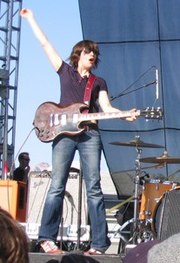Alternative rock
The underground punk rock movement inspired countless bands that either evolved from a punk rock sound or brought its outsider spirit to very different kinds of music. The original punk explosion also had a long-term effect on the music industry, spurring the growth of the independent sector. During the early 1980s, British bands like New Order and The Cure that straddled the lines of post-punk and New Wave developed both new musical styles and a distinctive industrial niche. Though commercially successful over an extended period, they maintained an underground-style, subcultural identity. In the United States, bands such as Minneapolis's Hüsker Dü and their protégés The Replacements bridged the gap between punk rock genres like hardcore and the more expansive sound of what was called "college rock" at the time.A 1985 Rolling Stone feature on the Minneapolis scene and innovative California hardcore acts such as Black Flag and Minutemen declared, "Primal punk is passé. The best of the American punk rockers have moved on. They have learned how to play their instruments. They have discovered melody, guitar solos and lyrics that are more than shouted political slogans. Some of them have even discovered the Grateful Dead." By the end of the 1980s, these bands, who had largely eclipsed their punk rock forebears in popularity, were classified broadly as alternative rock. Alternative rock encompasses a diverse set of styles—including gothic rock and grunge, among others—unified by their debt to punk rock and their origins outside of the musical mainstream.

As American alternative bands like Sonic Youth, who had grown out of the No Wave scene, and Boston's Pixies started to gain larger audiences, major labels sought to capitalize on the underground market that had been sustained by hardcore punk for years. In 1991, Nirvana emerged from Washington State's grunge scene, achieving huge commercial success with its second album, Nevermind. The band's members cited punk rock as a key influence on their style."Punk is musical freedom", wrote singer Kurt Cobain. "It’s saying, doing, and playing what you want." The widespread popularity of Nirvana and other punk-influenced bands such as Pearl Jam and Red Hot Chili Peppers fueled the alternative rock boom of the early and mid-1990s.
Emo
In its original, mid-1980s incarnation, emo was a less musically restrictive style of punk developed by participants in the Washington, D.C. area hardcore scene. It was originally referred to as "emocore", an abbreviation of "emotive hardcore". Notable early emo bands included Rites of Spring, Embrace, and One Last Wish. The term derived from the tendency of some of these bands' members to become strongly emotional during performances. Fugazi, formed out of the dissolution of Embrace, inspired a second, much broader based wave of emo bands beginning in the mid-1990s. Groups like San Diego's Antioch Arrow generated new, more intense subgenres like screamo, while others developed a more melodic style closer to indie rock. Bands such as Seattle's Sunny Day Real Estate and Mesa, Arizona's Jimmy Eat World broke out of the underground, attracting national attention. By the turn of the century, emo had arguably surpassed hardcore, its parent genre, as the roots-level standard for U.S. punk, though some music fans claim that typical latter-day purported emo bands like Panic! At The Disco and Fall Out Boy don't even qualify as punk at all.Queercore and riot grrrl

In the 1990s, the queercore movement developed around a number of punk bands with gay and lesbian members such as Fifth Column, God Is My Co-Pilot, Pansy Division, Team Dresch, and Sister George. Inspired by openly gay punk musicians of an earlier generation, queercore embraces a variety of punk and other alternative music styles. Queercore lyrics often treat the themes of prejudice, sexual identity, gender identity, and individual rights. The movement has continued to expand in the twenty-first century, supported by festivals such as Queeruption.
In 1991, a concert of female-led bands at the International Pop Underground Convention in Olympia, Washington, heralded the emerging riot grrrl phenomenon. Billed as "Love Rock Revolution Girl Style Now", the concert's lineup included Bikini Kill, Bratmobile, Heavens to Betsy, L7, and Mecca Normal. Singer-guitarists Corin Tucker of Heavens to Betsy and Carrie Brownstein of Excuse 17, bands active in both the queercore and riot grrrl scenes, cofounded the celebrated indie/punk band Sleater-Kinney in 1994. Bikini Kill's lead singer, Kathleen Hanna, the iconic figure of riot grrrl, moved on to form the art punk group Le Tigre in 1998.

0 comments:
Post a Comment